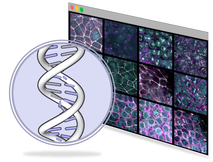OverviewThe Allen Institute for Cell Science has generated a collection of fluorescently tagged hiPSC clonal lines representing the major structures of the cell. All cell lines were generated using the wild type C hiPS cell line (WTC line) as the parental cell line. To establish a reference profile, we performed whole genome sequencing and population RNA-Seq on the WTC line. As part of our quality control process, we use whole exome sequencing and population RNA-Seq to evaluate any changes in the transcriptional profiles and exomes of our fluorescently tagged hiPSC lines relative to the parental WTC line. Raw data is available upon request - please email [email protected].
|
Parental WTC Genome
|
Explore the parental WTC short read whole genome sequence and variants in the UCSC Genome Browser:
|
|
Download the parental WTC whole genome raw data and variant calls:
|
Tagged Line Exomes
Explore the exomes and variants for our fluorescently tagged lines in the UCSC Genome Browser or download raw data and variant calls. One clone (public clone) for each gene tag is publicly available through Coriell.
Cell line & UCSC link |
Gene |
Tag |
Public clone |
PXN |
EGFP |
50 |
|
SEC61B |
mEGFP |
55 |
|
TOMM20 |
mEGFP |
27 |
|
TUBA1B |
mEGFP |
105 |
|
LMNB1 |
mEGFP |
210 |
|
FBL |
mEGFP |
6 |
|
ACTB |
mEGFP |
184 |
|
DSP |
mEGFP |
65 |
|
LAMP1 |
mEGFP |
37 |
|
TJP1 |
mEGFP |
84 |
|
MYH10 |
mEGFP |
80 |
|
ST6GAL1 |
mEGFP |
1 (mono-allelic); 44 (bi-allelic) |
|
MAP1LC3B |
mEGFP |
22 |
|
TUBA1B |
mTag-RFP-T |
35 |
|
CETN2 |
mTag-RFP-T |
19 |
|
SLC25A17 |
mEGFP |
115 |
|
TNNI1 |
mEGFP |
172 |
|
RAB5A |
mEGFP |
13 (mono-allelic); 35 (bi-allelic) |
|
ATP2A2 |
mEGFP |
51 |
|
GJA1 |
mEGFP |
16 |
|
AAVS1 |
mTagRFPT-CAAX |
91 |
|
NPM1 |
mEGFP |
50 |
|
CTNNB1 |
mEGFP |
67 |
|
HIST1H2BJ |
mEGFP |
36 |
|
NUP153 |
mEGFP |
88 |
Transcriptional Profiles
|
Download the transcriptional profiles of the parental WTC line and 13 fluorescently tagged lines.
|
|
Download our single cell RNA-sequencing data set of hiPSCs undergoing cardiac differentiation on Quilt. Data set includes 4 time points, 3 cell lines, 2 differentiation protocols, and multiple experimental replicates
|

